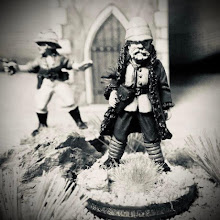 I haven't painted in awhile. Nothing like a game you're going to host to get you motivated when you realize you need 2 units!
I haven't painted in awhile. Nothing like a game you're going to host to get you motivated when you realize you need 2 units!I think my largest collection of figures are for the War of Spanish Succession. Let's face it, it's when men where men, wore lace, high heels and pitted our Irish against their Irish. What's not to love? I used to have my figures mounted for the excellent set of rules, Warfare in the Age of Reason; but then I discovered the first edition of Volley and Bayonet and I knew my large battle, horse and musket period troubles were over. The newest edition, Volley and Bayonet: The Road to Glory, is an improvement on the original rules and adds to more period flavor for the Napoleonic period.
If you like games where you decide the tactical formations of units, Volley and Bayonet is not the game for you. The standard units represent multi-battalion regiments and brigades with all of the figures mounted on one movement stand. The movement stands occupy the "tactical" space of the regiments and brigades. You, as the general, are concerned with the big picture: when to advance the right wing or throw in the reserves. The assumption is that the colonel and majors that command the battalions know what they are doing and will put their units in the right formation. You've got more important things to do, like command the army!
Anyway, my friend Michael Fox (creator of Dog Fight: Starship Edition) expressed an interest in gaming the period so I searched for a "small" battle to introduce the period to him. Honorable Son #4, another fan and undefeated general playing Volley and Bayonet, also wanted to play. I decided on one of the early battles of the War of Spanish Succession: The Battle of Friedlingen. The Battle of Friedlingen was fought on October 14, 1702 between the French commanded by Lieutenant General the Marquis de Villars and an Imperial army commanded by Markgraf Ludwig Wilhem von Baden-Baden. Say that 3 times real fast.
The scenario for the game is on The Volley and Bayonet Page under Historical Scenarios, 18th Century Battles. I'm going to modify the terrain based on the space I have available and I'm going to adjust the order of battle just a bit to play on a smaller table.
In reading the scenario, I noticed that both the French and Imperial forces will need 2 "skirmish" stands. In Volley and Bayonet, due to the scale, skirmish stands are not skirmishers with the exception of special rules for the Napoleonic period or later. The skirmish stands represent a detached battalion, usually for the purpose of holding key terrain. I already had two stands painted as dismounted dragoons in red jackets; they will work for the Imperials. In the actual battle, battalions of the French Infantry regiment La Marche occupy some earthworks known as the Schusterinsel. Since I haven't painted this unit, it presented a great excuse to paint.
Since I game the War of Spanish Succession in 15mm, for the "skirmish" stands I put 3 infantry or dismounted figures on each base. The beauty of Volley and Bayonet is that the amount of figures on the base does not matter; it's the size of the base that is used for play - making this game ideal for all sizes of figure scales. The overwhelming majority of figures in my collection are made by Dixon Miniatures. I had some extra dismounted dragoons, and for 15mm scale, they look close enough to infantry that I can get away with using them. Plus, they can be used as generic dismounted dragoons in a later game.
At this time the Regiment La Marche has white coats, red vests, red collars, yellow buttons and yellow trim on their tricorne hats. White can always be a challenge to get a look that gives depth without it the white looking too bright. Here is the technique I use if I'm not in a hurry.
Figures are spray painted black with Krylor's flat black (which is available at most hardware or retail stores in the USA). All other paints I used are from Game Workshop. The base color for the coat is Bestial Brown and the base for the skin is Dark Flesh.

Once dry, I went over the coat with Bone White, trying to leave the folds of the jackets the brown color.

To finish the face and hands, I used Dwarf flesh and then highlighted the high points with Elf Flesh.

I decided not to use a base color for the red. Instead I gave the red cuffs and vest 2 two coats of Blood Red.

The wood on the musket is painted Bestial Brown and the muzzle and firelock are Chainmail. The trigger housing is painted Shining Gold. Now I finish the jacket with Skull White on the high points leaving the edges Bone White. The scarf I just paint Skull White over the black to make it brighter than the jacket.

To finish up the straps, musket sling, belts and cartridge box are painted Bubonic Brown. The scabbard for the sword is Bestial brown and the sword's hilt is shining gold. Bayonet scabbard is black as are the boots while the buttons and hat lace is Sunburst Yellow.


I mount the figures on wood bases and attach the flocking with watered down white glue. Now the honor of France can be upheld holding on to those fortifications!





Nice walkthrough on the figure painting.
ReplyDeleteNice work!
ReplyDelete